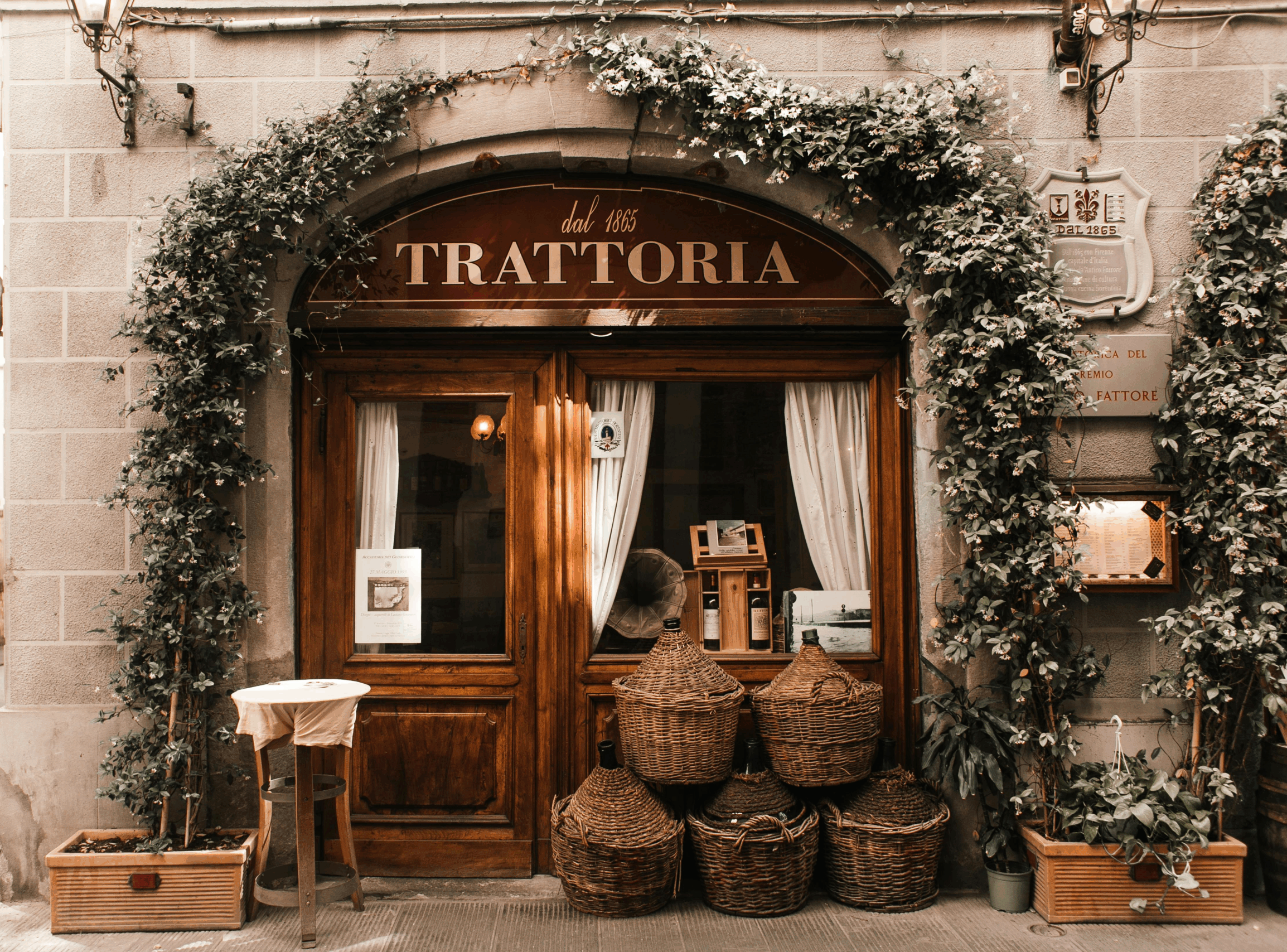Tuscany: Cradle of Genius, Heart of Italy
Tuscany is not just a place—it’s a journey through time. In this Tuscany travel guide, you’ll explore Etruscan origins, Renaissance masterpieces, medieval hill towns, and the flavors that define one of Italy’s most celebrated regions. From Siena’s Palio to the vineyards of Chianti, this in-depth guide reveals the best things to do in Tuscany, the region’s rich history, when to visit, and how to immerse yourself in its living culture.
From the luminous frescoes of Florence to the vineyard-dotted slopes of Chianti, Tuscany’s landscape is a living canvas. The region’s story is written in stone—Etruscan walls, Roman amphitheaters, Gothic cathedrals, and Renaissance palaces—each era adding a chapter to its cultural legacy.
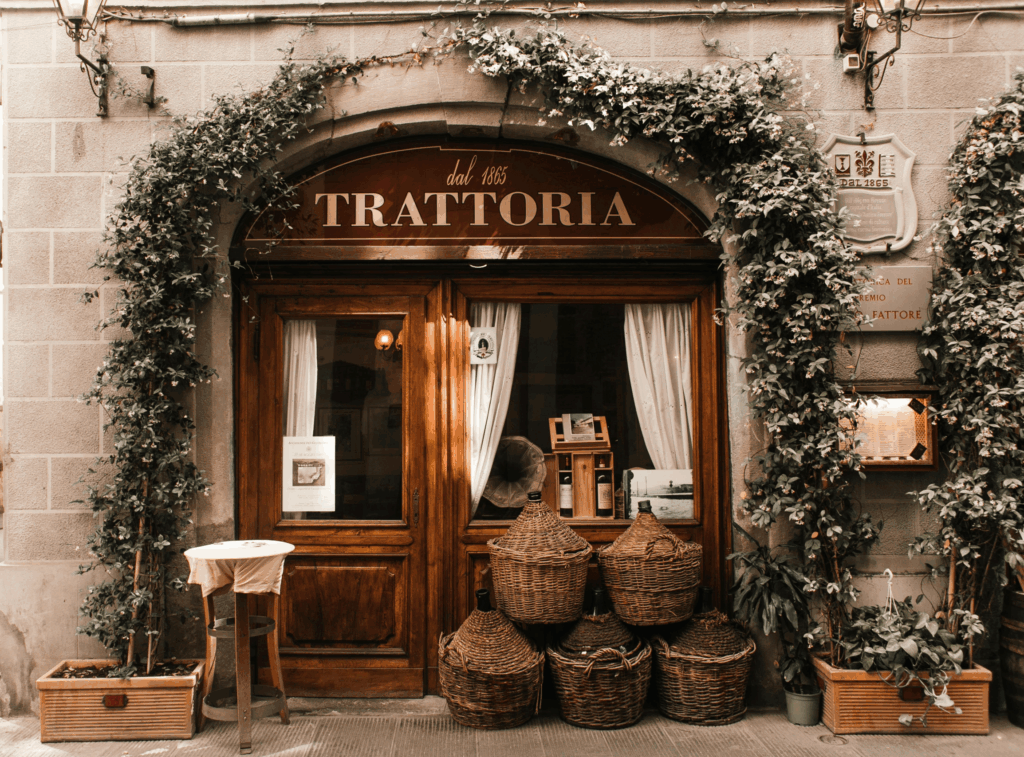
Tuscany’s Ancient World: Etruscan Beginnings
Before Florence’s Renaissance brilliance or Siena’s medieval glory, Tuscany was the homeland of the Etruscans—an ancient civilization whose artistry, engineering, and mystique still echo across the hills. Flourishing between the 8th and 3rd centuries BCE, they were not a single empire but a confederation of independent city-states such as Volterra, Cortona, Chiusi, Tarquinia, and Arezzo, each with its own rulers yet bound by a shared language, religion, and cultural identity.
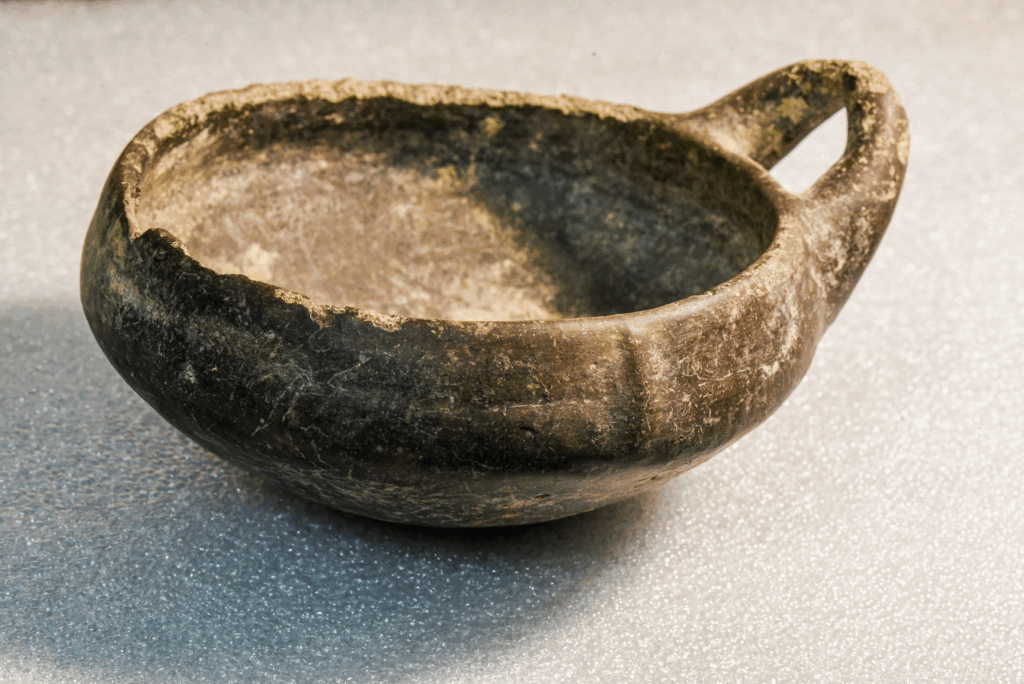
Who They Were
Greek historians described the Etruscans (or Rasenna, as they called themselves) as a seafaring, sophisticated people—prosperous from trade, gifted in metallurgy, and deeply spiritual. They saw life as a tapestry woven between the mortal and divine, with elaborate rituals to honor their gods and guide the dead into the afterlife. Women in Etruscan society enjoyed freedoms rare in the ancient world—appearing alongside men at banquets, owning property, and participating in civic life—leaving an impression of a society more egalitarian than their Greek or Roman neighbors.
Art and Architecture
The Etruscans were master builders, famed for their use of the arch and their skill in engineering complex drainage systems—techniques later adopted and perfected by the Romans. Their cities rose on defensible hilltops, protected by massive stone walls and monumental gates. In Volterra, the Porta all’Arco, dating to the 4th century BCE, still greets visitors with its weathered basalt blocks and sculpted heads, silent sentinels from a vanished age.
Tombs as Cities for the Dead
In life, the Etruscans favored richly painted homes and temples; in death, they built entire cities for the departed. In necropolises like Banditella and Cerveteri (just beyond Tuscany’s modern borders), the tombs mirror domestic architecture—doorways, roof beams, and even furniture carved from stone. Frescoes depict banquets, musicians, and dancers, capturing not solemnity but joy, as if to say that the pleasures of life continued beyond the grave.
Etruscan Treasures Today
- Guarnacci Etruscan Museum (Volterra) — One of Italy’s oldest public collections, including alabaster funerary urns with expressive sculpted lids.
- Museo dell’Accademia Etrusca (Cortona) — Bronze votive statues, intricate jewelry, and household items that bridge the gap between archaeology and anthropology.
- Chiusi’s Underground Tunnels — Once part of an Etruscan water system, these labyrinthine passages now form an atmospheric museum experience.
Rome in Tuscany: Roads, Theaters & a City Called Florentia
By the 3rd century BCE, the rising power of Rome — once a small settlement on the Tiber that had grown into the dominant force of central Italy — had turned its gaze north. The patchwork of Etruscan city-states was gradually absorbed into the Roman Republic, sometimes by treaty, often by conquest. Yet rather than erase the Etruscans, Rome folded their expertise into its own machine — borrowing their divination rituals, engineering tricks, and even the use of the arch.
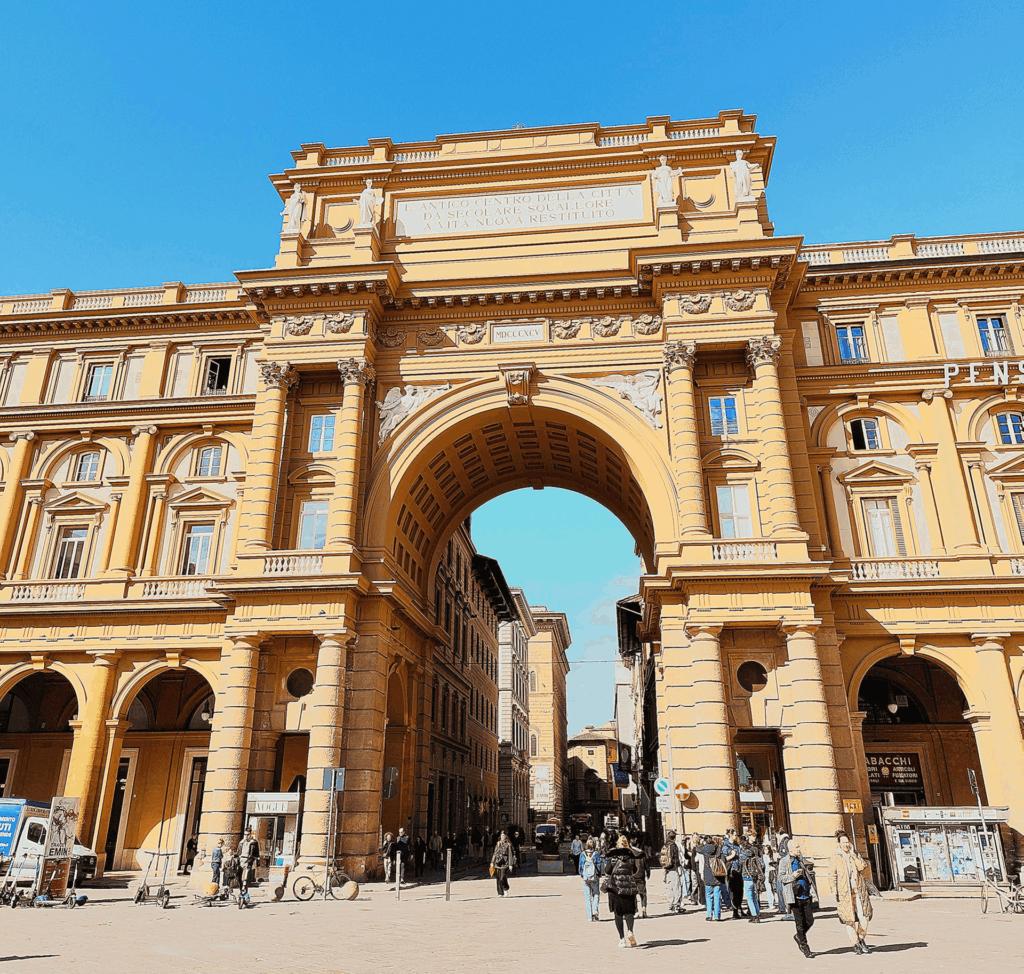
For Tuscany, this meant transformation. Hill towns that once looked inward became outposts in a continental empire. Rome overlaid its order onto the landscape with what it did best: roads, grids, and public life. Straight stone roads cut through valleys to connect Florence, Lucca, Pisa, and Arezzo with the wider Roman world, making Tuscany a crucial north–south corridor between Rome and the Alps.
Florence itself was born Roman: founded as Florentia in 59 BCE, a military colony laid out on the classic cardo and decumanus (north–south and east–west axes). Those lines still survive as Via Roma and Via Calimala, proof that the bones of Roman planning still structure the city today.
Unlike the mystical, hilltop focus of the Etruscans, the Romans were about scale and spectacle. Amphitheaters, baths, and forums sprouted across Tuscany — places where citizens debated, bathed, worshiped, and watched performances. The capital of the empire was of course Rome itself, but Tuscany was no backwater; it became a vital province feeding into the lifeblood of the city and, later, a favored retreat for wealthy Romans drawn to its fertile fields and coastal villas.
Tuscany Travel Guide: Roman Sites You Can Visit Today
Florentia (Florence)
Founded as a Roman colony in the first century BCE, Florentia followed the classic grid. The cardo and decumanus survive as today’s Via Roma and Via Calimala. Stand in Piazza della Repubblica — you’re on the site of the Roman forum.
Fiesole
High above Florence, Fiesole keeps its Roman theater and baths intact. It’s an easy hop for a half-day — pair the ruins with the small archaeology museum for context, then linger over a view that outlasted two millennia.
Lucca
The oval Piazza dell’Anfiteatro sits inside the footprint of a Roman amphitheater. Houses curve where tiers of seats once rose, a neat lesson in how Rome’s bones still shape Tuscan streets.
Arezzo
Fragments of an amphitheater anchor the city’s archaeology museum. It’s a short, rewarding add-on to any Arezzo wander — especially if you’re there for the antiques market.
Volterra
Beyond Etruscan walls you’ll find a first-century BCE Roman theater cut into the slope. Walk the tiers at golden hour and you’ll see why the Romans loved natural acoustics.
Cortona
Look for Roman layers tucked beneath medieval streets, plus inscriptions and artifacts at the MAEC that trace the handoff from Etruscan to Roman rule.
Cosa (Ansedonia, southern Tuscany)
For ruin lovers, the hilltop colony of Cosa overlooks the Maremma coast with forum remains, walls, and a small museum that make the republic feel close.
How to Experience Rome-in-Tuscany Today
- Follow the lines: Walk Florence’s Via Roma → Piazza della Repubblica → Via Calimala to trace Florentia’s grid in 10 minutes.
- Catch a performance: Summer concerts sometimes return to Fiesole’s theater — a memorable way to time-travel.
- Read the stones: In Lucca, pause under the arches off Piazza dell’Anfiteatro to spot reused Roman blocks in medieval walls.
- Pair and compare: Do an Etruscan-then-Roman day — Volterra’s Porta all’Arco and museum, then the Roman theater — to see how one civilization flowed into the next.
With the Etruscans came mystery and artistry; with the Romans, order and scale. Roads, theaters, and forums knit Tuscany into the fabric of an empire whose capital lay far to the south. Yet history never stood still here. As Rome’s power waned and the Middle Ages reshaped Europe, Tuscany carried those ancient foundations forward — stone by stone, street by street — until Florence ignited a movement that reshaped Western civilization.
Florence and the Fire of the Renaissance
Between the 14th and 16th centuries, this compact city-state became the beating heart of the Renaissance—an intellectual and artistic revolution that revived classical ideals, embraced humanism, and elevated art and science to new heights.

A City-State Poised for Greatness
Florence’s transformation was fueled by a potent mix of wealth, politics, and ambition. The Medici family—bankers to popes and monarchs—understood the power of art as both civic pride and political messaging. Their patronage drew talent from across Europe, creating an atmosphere where innovation was as prized as tradition.
Architecture That Defined an Era
- Santa Maria del Fiore (Florence Cathedral): Brunelleschi’s dome was an engineering marvel—built without scaffolding, it spanned wider and soared higher than anything attempted since antiquity.
- Palazzo Vecchio: A fortress-palace whose crenellated tower presided over the city’s political life, from republican councils to Medici rule.
- Basilica of San Lorenzo: Brunelleschi’s revival of classical harmony and proportion set a new architectural language.
Masters of the Renaissance
- Leonardo da Vinci sketched flying machines in notebooks that blurred the line between art and engineering.
- Michelangelo sculpted David as a symbol of civic courage and divine perfection, standing tall in the Piazza della Signoria before moving indoors to the Accademia Gallery.
- Botticelli’s Primavera and Birth of Venus at the Uffizi Gallery reimagined mythological subjects with an ethereal elegance that still stirs visitors. For a fictional dive into the passion and politics behind this masterpiece, read our review of the historical novel The Birth of Venus in our Books & Films edit.
The Human Drama
Florence’s Renaissance wasn’t all marble and fresco—it was also blood and fire. Niccolò Machiavelli, political theorist and author of The Prince, chronicled the ruthless realities of power. Preacher Girolamo Savonarola’s calls for religious reform ended in a pyre in the very Piazza where he burned “vanities” only years before. Art was propaganda, politics was performance, and Florence thrived in the tension between beauty and brutality.
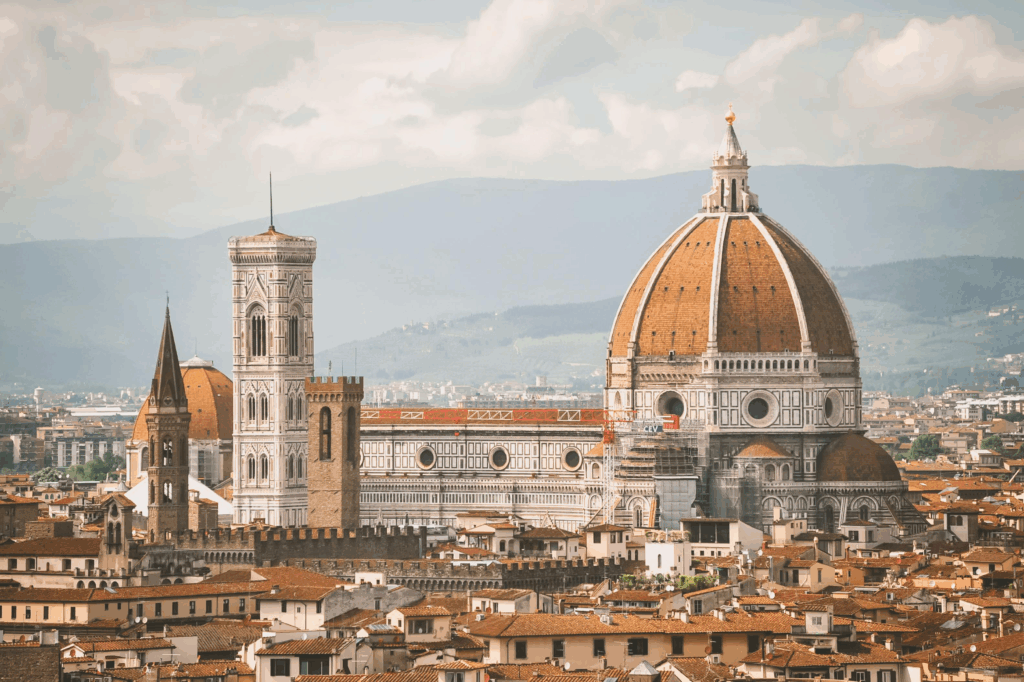
Experiencing Florence Today
- Stand in Piazza del Duomo at sunrise, when the marble façades glow pink in the early light.
- Walk the Vasari Corridor, once a private Medici passage, connecting political and residential centers in a single elevated stroll.
- Sip espresso at an open-air café, the hum of Vespas and church bells blending into a modern symphony overlaid on centuries-old streets.
Florence remains a city where the Renaissance feels near enough to touch—its innovations still visible in every arch, column, and cobblestone.
These structures weren’t just beautiful—they embodied the Renaissance belief in human potential, the idea that man could shape his world with intellect and creativity.
Siena, San Gimignano, and the Gothic Spirit: A Tuscany Travel Guide Highlight
While Florence surged forward with Renaissance innovations, Siena followed its own path—rooted in Gothic elegance, civic pride, and fierce independence, offering a distinct chapter in any Tuscany travel guide.
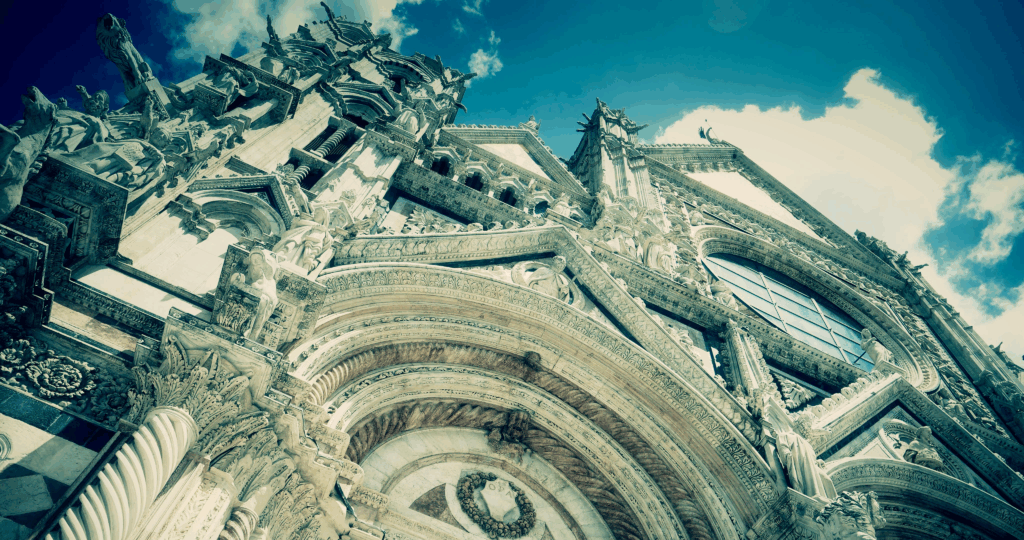
Siena: A Gothic Jewel
At the heart of Siena’s medieval cityscape stands the Duomo di Siena, a cathedral unlike any other. Its façade of black-and-white striped marble—symbolizing the city’s heraldic colors—glitters with gilded mosaics and sculpted saints. Inside, carved pulpits, inlaid marble floors depicting biblical scenes, and Piccolomini Library frescoes by Pinturicchio immerse visitors in a kaleidoscope of craftsmanship.
Civic pride found visual form in the Palazzo Pubblico, home to Ambrogio Lorenzetti’s Allegory of Good and Bad Government. Painted in the 1330s, these frescoes remain one of the earliest and most insightful visual essays on civic virtue and corruption—art with a political conscience that still resonates.
San Gimignano: The City of Towers
In the 14th century, wealthy merchant families built tower houses as both status symbols and defensive structures; at the city’s peak, 72 towers punctuated the horizon. Today, 14 remain, their weathered stone and dizzying height still commanding awe. Climbing the Torre Grossa offers a sweeping view of vine-striped hills and silver-green olive groves—landscapes that have changed little in centuries.
Rivalry and Identity
Siena and Florence’s competition extended beyond the battlefield. Where Florence embraced Renaissance proportion and classical revival, Siena held fast to Gothic ornamentation—its pointed arches, elaborate façades, and narrative frescoes asserting a distinct visual identity. This was architecture as diplomacy, each stone laid with the intention of declaring, We are not Florence.
Experiencing the Gothic Spirit Today
- Stroll Siena’s Piazza del Campo, shaped like a scallop shell, where cafés spill into one of Europe’s most beautiful public squares—an unmissable stop when exploring things to do in Tuscany.
- Time your visit for the Palio di Siena, when the square transforms into a horse-racing arena, the air electric with centuries-old rivalries.
- Wander San Gimignano’s quieter side streets at dawn, when the towers cast long shadows over empty stone lanes.
Tuscany Beyond the Renaissance: Reform, Unification, and War
When the brilliance of the Renaissance began to fade, Tuscany entered a quieter yet still pivotal era—marked by political transition, Enlightenment reform, and, centuries later, the turmoil of modern war, all of which is detailed in this Tuscany travel guide.
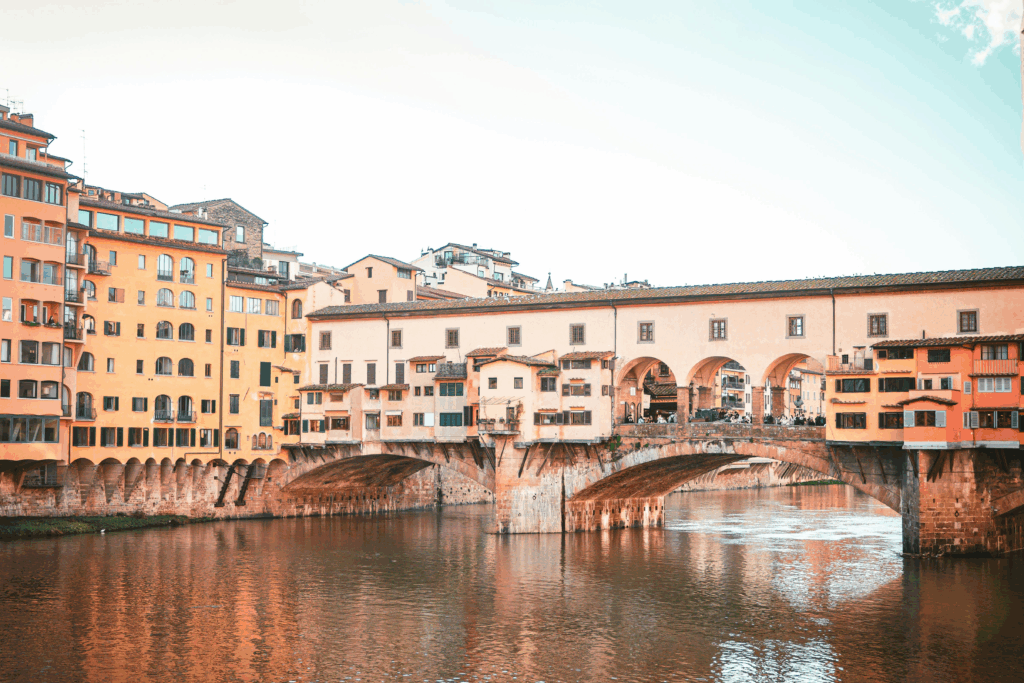
From Medici to Lorraine
The Medici family’s Grand Duchy period extended well past their artistic golden age. They continued to fund architectural projects—remodeling palaces, restoring churches, and shaping urban planning. But by the early 18th century, the dynasty was dwindling. When Gian Gastone de’ Medici, the last male heir, died in 1737 without children, Tuscany’s fate was no longer in local hands.
International politics had already sealed its future. In the aftermath of the War of the Polish Succession (1733–1738), European powers used the Treaty of Vienna to reshuffle territories. Tuscany was seen as a valuable and stable prize in central Italy, and the agreement awarded it to Francis Stephen of Lorraine, Duke of Lorraine, in exchange for him surrendering his own duchy to France’s ally, Stanisław Leszczyński, the former King of Poland.
This move not only secured diplomatic peace but also tightened Austria’s grip on Italy—Francis Stephen was engaged to Maria Theresa of Austria, ensuring Tuscany would be ruled by the new Habsburg-Lorraine dynasty.
Enlightenment Influence
The Habsburg-Lorraines brought a wave of Enlightenment-inspired policies. Under Grand Duke Leopold I (later Holy Roman Emperor Leopold II), Tuscany abolished the death penalty in 1786—making it the first modern state to do so. Infrastructure improved, education expanded, and civic buildings reflected the cleaner lines and balanced proportions favored in the Enlightenment era.
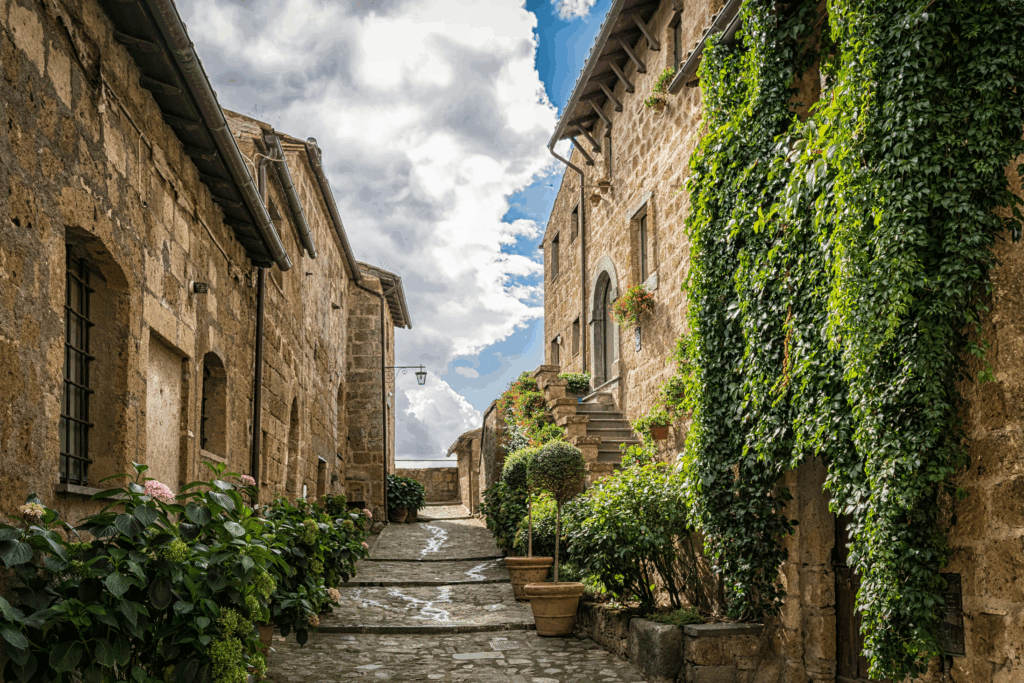
The Risorgimento and Unification
In the mid-19th century, Tuscany became part of the Risorgimento, the sweeping movement to unify Italy’s patchwork of kingdoms, duchies, and city-states into a single nation. After the Risorgimento wars pushed Austrian influence out of much of northern and central Italy, the question of Tuscany’s future was put directly to its people.
In 1860, a plebiscite—a popular vote on a single political issue—was held to decide whether Tuscany should join the newly forming Kingdom of Italy under King Victor Emmanuel II. While voting rights at the time were limited to a small portion of the population (mostly property-owning men), the results were overwhelmingly in favor of unification, with roughly 95% voting “Yes.”
This plebiscite gave the annexation legitimacy in the eyes of both Italians and foreign powers, and Tuscany officially joined the Kingdom of Italy later that year. Florence would go on to serve as the nation’s capital from 1865 to 1871, an era that left behind grand boulevards, civic buildings, and the modern Piazza della Repubblica as symbols of a newly united Italy—an essential landmark in any Tuscany travel guide.
World War II: Occupation, Resistance, and Liberation
The 20th century brought one of Tuscany’s darkest and most politically complex chapters. After Italy entered WWII on the side of Nazi Germany in 1940, the tides turned in 1943 when Mussolini was deposed and Italy signed an armistice with the Allies. German forces swiftly occupied central and northern Italy, including Tuscany, transforming it into a militarized zone along the Gothic Line—a heavily fortified defensive barrier running across the Apennine Mountains.
Life Under Occupation
The Germans controlled major cities and transport routes, requisitioned supplies, and enforced harsh reprisals for resistance activity. Fascist loyalists worked alongside the occupiers, while many ordinary Italians were caught between survival and resistance. In Florence, entire neighborhoods near the Arno were demolished in 1944 to block the Allied advance—though the Ponte Vecchio and Duomo were miraculously spared.
The Resistance Movement: Across Tuscany’s hills and villages, partisan groups—made up of farmers, students, former soldiers, and even clergy—waged guerrilla warfare. They sabotaged rail lines, guided Allied troops through mountain passes, and sheltered Jewish families and Allied airmen at great personal risk. The Resistance was as much about reclaiming national dignity as it was about military victory, and it played a defining role in shaping postwar Italian politics.
Although not set in Tuscany, Beneath a Scarlet Sky by Mark Sullivan vividly captures this same spirit of resistance. Based on the true story of Pino Lella, a young man who risked his life guiding Jewish refugees across the Alps and later spied on Nazi officers, the novel brings the peril and courage of wartime Italy into sharp focus. For more powerful stories rooted in Tuscany itself, don’t miss our [Tuscany Books & Films Edit].
Tragedy and Atrocity: The struggle was brutal. The Sant’Anna di Stazzema massacre in August 1944 saw over 500 civilians—mostly women, children, and the elderly—killed by Nazi troops in retaliation for partisan activity. Similar massacres scarred smaller villages, leaving memorials that still bear witness to the human cost of war.
Liberation: Allied forces began liberating Tuscany in the summer of 1944. Florence was freed in August after days of street fighting, but the damage was extensive—bridges blown, art looted, and infrastructure shattered. In the countryside, vineyards, olive groves, and farmhouses bore the marks of bombardment and shellfire.
Rebuilding and Renewal
After the war, Tuscany approached restoration as both a necessity and a cultural mission. International art recovery teams worked to return stolen paintings and repair bomb-damaged churches. Frescoes blackened by smoke were painstakingly cleaned, piazzas rebuilt stone by stone, and abandoned rural estates reborn as agriturismos, blending heritage with sustainable tourism. This careful balance of preservation and renewal has shaped the region’s identity ever since, allowing medieval walls, Renaissance churches, Enlightenment palaces, and modern memorials to coexist in harmony.
Living Heritage: Markets, Festivals, and Traditions in Tuscany
In Tuscany, history is not confined to museum walls—it spills into the piazzas, market stalls, and seasonal celebrations that shape daily life. If you’re looking for an authentic experience, this Tuscany travel guide is here to help. Here, centuries-old traditions are not staged performances but living rituals that tie communities to their past.

Markets as Time Capsules
Every month in Arezzo, the historic center transforms into one of Italy’s largest antique markets, where over 500 stalls sell everything from Renaissance furniture to vintage linens and hand-painted ceramics. In Lucca, the intact Renaissance-era city walls now encircle a vibrant weekly market where locals shop for fresh pecorino, seasonal produce, and handwoven baskets—practices that have changed little over generations.
The Palio di Siena: A Medieval Rivalry Alive Today
Held twice each summer, in July and August, the Palio di Siena is far more than a horse race—it’s an expression of civic pride and fierce neighborhood loyalty. Ten of Siena’s contrade (districts) compete, their jockeys riding bareback around the scallop-shaped Piazza del Campo at breakneck speed. The buildup includes processions in medieval costume, blessings of the horses in local churches, and a palpable tension that electrifies the city, making it one of the most unforgettable things to do in Tuscany.
Seasonal Traditions
- Vendemmia (Grape Harvest): In September and October, vineyards across Chianti, Montalcino, and Montepulciano invite visitors to join in harvesting grapes, followed by long communal lunches paired with the season’s first wine.
- Olive Oil Festivals: November brings pressing season, with villages celebrating the olio nuovo—bright green, peppery new olive oil—with tastings drizzled over fresh bread.
- Truffle Hunts: Autumn also marks white truffle season in San Miniato, where guided hunts with dogs are followed by market stalls selling the prized fungi.
Festivals Rooted in Faith and History
- Capodanno Fiorentino (Florentine New Year): Celebrated on March 25, aligning with the Feast of the Annunciation, this event predates the Gregorian calendar and includes a historical parade from the Palagio di Parte Guelfa to the Basilica of Santissima Annunziata.
- Calcio Storico: Florence’s gritty, Renaissance-era sport—part rugby, part wrestling—played in Piazza Santa Croce each June with players in 16th-century costume.
- Ferragosto: A nationwide holiday on August 15 celebrating the Assumption of the Virgin, marked in Tuscany by outdoor feasts, concerts, and fireworks in towns from Pisa to small rural villages.
Experiencing Living Tuscany
To truly connect with Tuscan culture, join the locals: browse a Saturday market in a hill town, linger over a glass of Chianti Classico in a sunlit piazza, or follow the sound of drums to a festival procession winding through medieval streets. Here, the rhythms of daily life are shaped by traditions that are not only remembered—they’re lived.
While a stroll through Siena is unforgettable, some experiences elevate a trip to another level. For vetted recommendations on private cooking classes and truffle hunting excursions, see our list of Exclusive Tuscan Experiences, and to book a trusted local guide, explore our Tuscany Travel Resources.
Culinary Traditions: A Tuscany Travel Guide for Foodies
Tuscan cuisine is built on the philosophy that the simplest dishes, made with the best ingredients, can be the most profound. Known as cucina povera (“poor cooking”), this tradition reflects centuries of making the most of what the land and seasons provided—yet over time, these humble origins have evolved into one of the most celebrated regional cuisines in the world.

Hearty Soups and Bread-Based Classics
Bread is the soul of Tuscan cooking—and it’s famously unsalted. This tradition dates back to medieval tax disputes between Pisa and Florence, when salt was heavily taxed and Florentines simply omitted it. The result is a bread that becomes the perfect foundation for other flavors.
- Ribollita: A hearty vegetable-and-bean soup thickened with day-old bread, often made in large batches and “reboiled” the next day for even deeper flavor.
- Pappa al Pomodoro: Ripe tomatoes, olive oil, garlic, basil, and stale bread simmered into a thick, fragrant comfort food—especially beloved in summer.
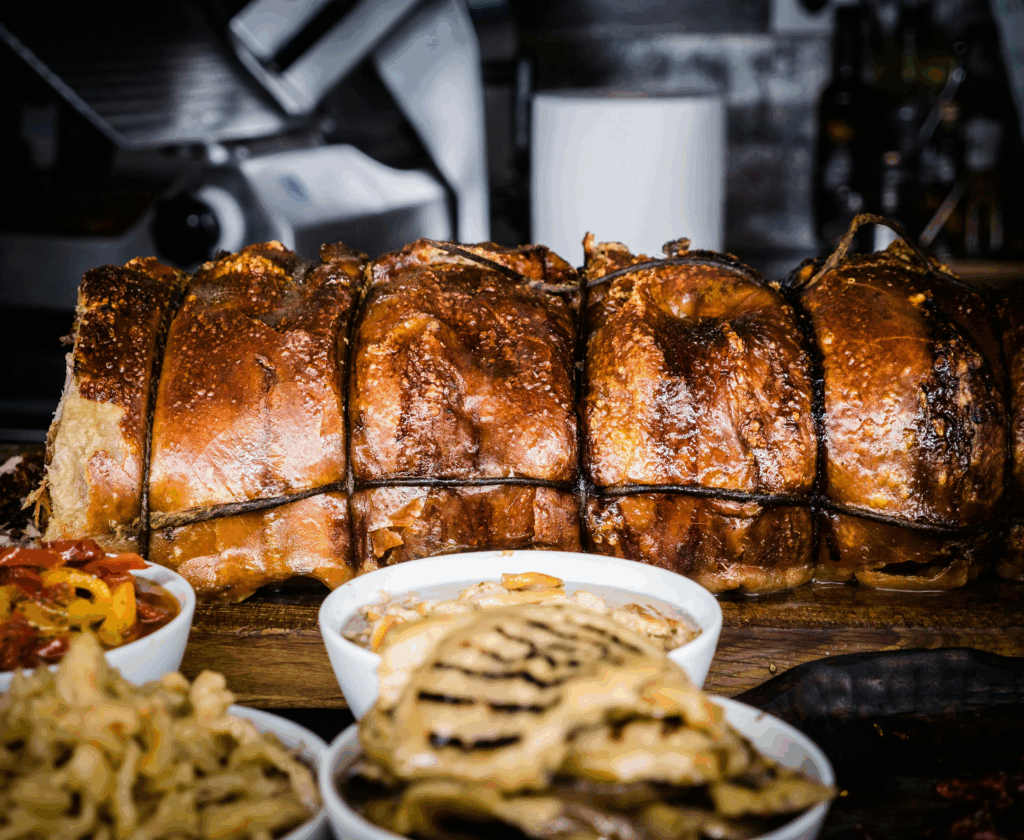
Meat and Game Specialties
- Bistecca alla Fiorentina: The quintessential Tuscan steak, cut thick from Chianina cattle, grilled over wood embers, and served rare. Its simplicity lets the quality of the beef speak for itself.
- Cinghiale (Wild Boar): Slow-cooked in red wine with herbs and spices, often served over pappardelle pasta.
- Porchetta: Herb-stuffed, slow-roasted pork, often sold at festivals and markets.
Seasonal Treasures
- White Truffles: Found in autumn in the hills around San Miniato, these are shaved over pasta, eggs, or risotto for an earthy, intoxicating aroma.
- Extra-Virgin Olive Oil: Tuscany’s green-gold pride, best enjoyed fresh and peppery over grilled bread (bruschetta) or vegetables.
- Chestnuts: In the Garfagnana region, chestnut flour becomes pancakes (necci) or polenta in the cooler months.
The Wines of Tuscany
- Chianti Classico: Ruby red, with bright acidity and flavors of cherry and herbs.
- Brunello di Montalcino: A full-bodied, age-worthy Sangiovese with complex notes of plum, leather, and spice.
- Vino Nobile di Montepulciano: Elegant and velvety, perfect with roasted meats.
- Vin Santo: A sweet, amber-hued dessert wine traditionally served with almond biscotti (cantucci) for dipping.
Here in Tuscany, food is never just sustenance—it’s memory, tradition, and place, all served on the same plate.
Guide to the Best Times to Visit Tuscany: Seasons, Weather, and Atmosphere
Tuscany is beautiful year-round, but the experience shifts dramatically with the seasons. Choosing when to go depends on what you value most—mild weather, cultural events, fewer crowds, or golden harvest landscapes. This Tuscany travel guide will help you decide the best time to visit Tuscany based on your interests.
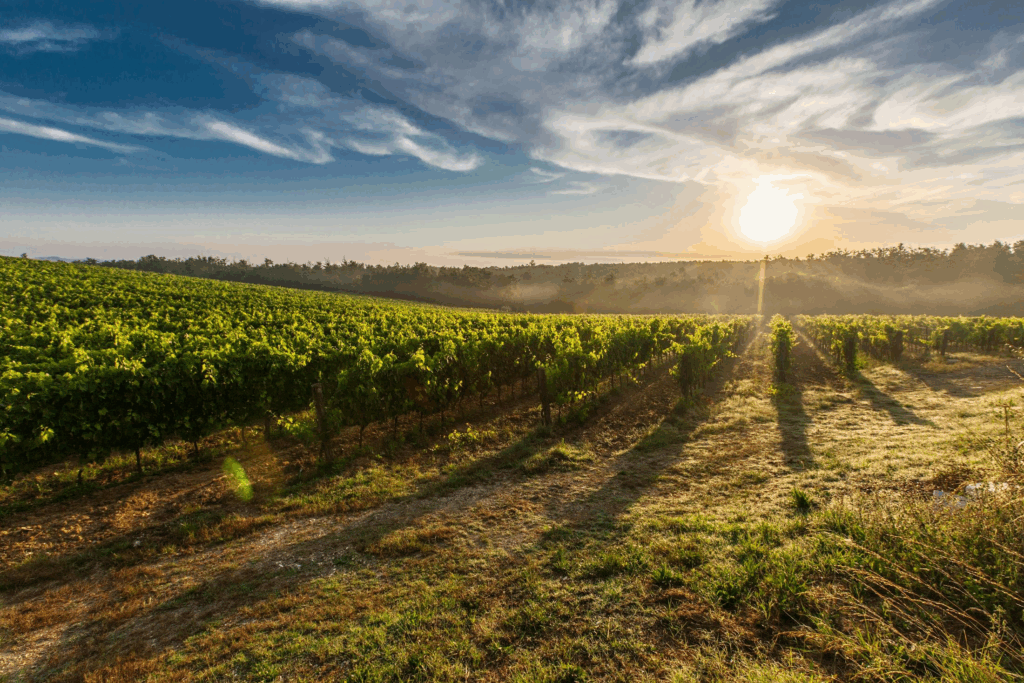
Spring (April–June)
- Weather: Mild and pleasant, 60–75°F (15–24°C). Occasional showers bring lush green hills and blooming wildflowers.
- Pros: Easter celebrations, floral festivals, long daylight hours.
- Cons: May and June bring rising crowds in major cities; prices increase.
Early Summer (Late June–Early July)
- Weather: Warm and sunny, 75–85°F (24–29°C).
- Pros: Long days, sunflower fields, vibrant festivals.
- Cons: Higher prices, large tour groups, Palio crowds in Siena.
High Summer (Mid–Late July & August)
- Weather: Hotter, sometimes over 90°F (32°C) in lowlands.
- Pros: Peak festival season, lively coastal towns.
- Cons: Tourist density, Ferragosto closures in August.
Autumn (September–October)
- Weather: 65–80°F (18–27°C) with golden harvest light.
- Pros: Vendemmia, truffle season, fewer crowds after mid-October.
- Cons: Shorter days, cooler evenings.
Winter (November–March)
- Weather: 40–55°F (4–13°C), fog in valleys, occasional snow in mountains.
- Pros: Quiet towns, low prices, Christmas markets.
- Cons: Limited rural services, short daylight hours.
Now that you know when to go, find out exactly what to pack for every season with our complete Tuscany Style & Packing Guide.

Tuscany Awaits: Go Beyond this Tuscany Travel Guide & Explore Our Curated Collections
Tuscany is more than a destination—it’s an experience that unfolds slowly, like a fine wine breathing in the glass. Its history is written in hilltop skylines and marble façades, its culture tasted in olive oil and truffles, and its spirit felt in the warmth of a bustling piazza at sunset. This Tuscany travel guide is just the beginning; use our resources to plan your own unforgettable journey traveling in Tuscany.
To deepen your journey, explore our curated collections across Jet Set Edits:
- Books & Films — Under the Tuscan Sun, Tea with Mussolini, and more.
- Style & Packing — Outfits for vineyard tours, winter museum days, and summer festivals.
- Exclusive Experiences — Private wine tastings, truffle hunts, and art history tours.
- Travel Resources — Boutique hotels, train routes, and trusted guides.
Whether you come for the art, the food, the festivals, or the landscapes, Tuscany rewards the traveler who lingers—who takes time to watch the light shift across a vineyard, to savor the last sip of Vin Santo, to listen to the echo of footsteps on centuries-old cobblestones.
Let Jet Set Edits be your companion in planning a journey that is as beautiful, timeless, and layered as Tuscany itself.
